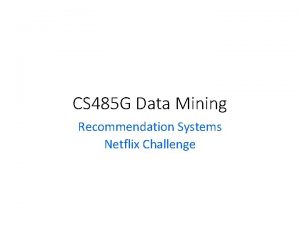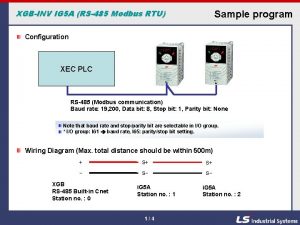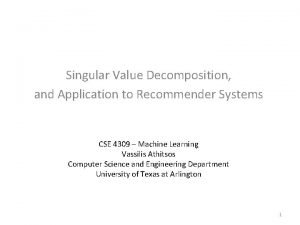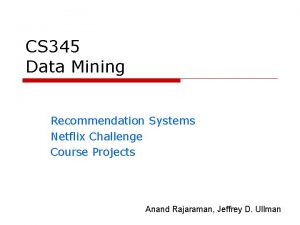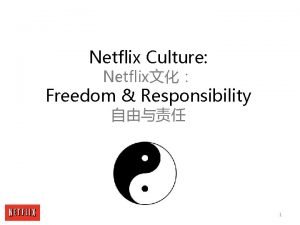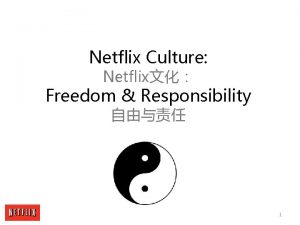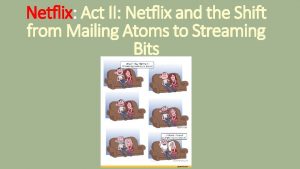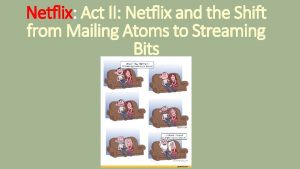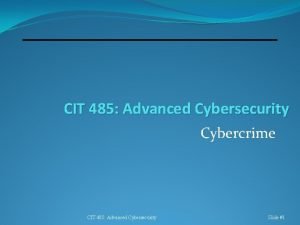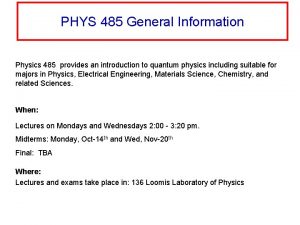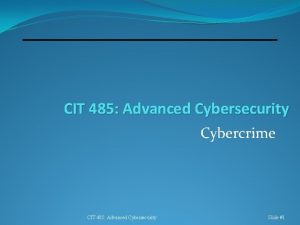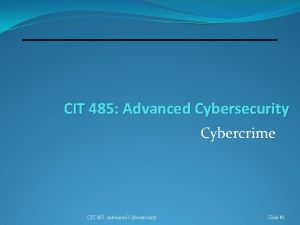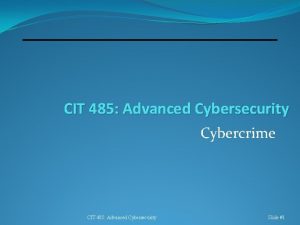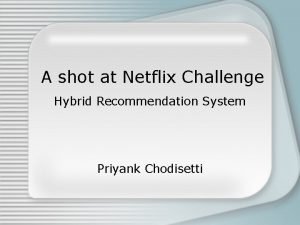CS 485 G Data Mining Recommendation Systems Netflix




























- Slides: 28

CS 485 G Data Mining Recommendation Systems Netflix Challenge

Recommendations Search Items Products, web sites, blogs, news items, …

From scarcity to abundance • Shelf space is a scarce commodity for traditional retailers • Also: TV networks, movie theaters, … • The web enables near-zero-cost dissemination of information about products • From scarcity to abundance • More choice necessitates better filters • Recommendation engines • How Into Thin Air made Touching the Void a bestseller

The Long Tail Source: Chris Anderson (2004)

Recommendation Types • Editorial • Simple aggregates • Top 10, Most Popular, Recent Uploads • Tailored to individual users • Amazon, Netflix, …

Formal Model • C = set of Customers • S = set of Items • Utility function u: CXS->R • R = set of ratings • R is a totally ordered set • e. g. , 0 -5 stars, real number in [0, 1]

Utility Matrix King Kong Alice Bob Carol David LOTR Matrix Nacho Libre

Key Problems • Gathering “known” ratings for matrix • Extrapolate unknown ratings from known ratings • Mainly interested in high unknown ratings • Evaluating extrapolation methods

Gathering Ratings • Explicit • Ask people to rate items • Doesn’t work well in practice – people can’t be bothered • Implicit • Learn ratings from user actions • e. g. , purchase implies high rating • What about low ratings?

Extrapolating Utilities • Key problem: matrix U is sparse • most people have not rated most items • Three approaches • Content-based • Collaborative • Hybrid

Content-based recommendations • Main idea: recommend items to customer C similar to previous items rated highly by C • Movie recommendations • recommend movies with same actor(s), director, genre, … • Websites, blogs, news • recommend other sites with “similar” content

Plan of action likes Item profiles build recommend match Red Circles Triangles User profile

Item Profiles • For each item, create an item profile • Profile is a set of features • movies: author, title, actor, director, … • text: set of “important” words in document • How to pick important words? • Usual heuristic is TF. IDF (Term Frequency times Inverse Doc Frequency)

TF. IDF fij = frequency of term ti in document dj ni = number of docs that mention term i N = total number of docs TF. IDF score wij = TFij * IDFi Doc profile = set of words with highest TF. IDF scores, together with their scores

User profiles and prediction • User profile possibilities: • Weighted average of rated item profiles • Variation: weight by difference from average rating for item • … • Prediction heuristic • Given user profile c and item profile s, estimate u(c, s) = cos(c, s) = c. s/(|c||s|) • Need efficient method to find items with high utility: later

Model-based approaches • For each user, learn a classifier that classifies items into rating classes • liked by user and not liked by user • e. g. , Bayesian, regression, SVM • Apply classifier to each item to find recommendation candidates • Problem: scalability • Won’t investigate further in this class

Limitations of content-based approach • Finding the appropriate features • e. g. , images, movies, music • Overspecialization • Never recommends items outside user’s content profile • People might have multiple interests • Recommendations for new users • How to build a profile?

Collaborative Filtering • Consider user c • Find set D of other users whose ratings are “similar” to c’s ratings • Estimate user’s ratings based on ratings of users in D

Similar users • Let rx be the vector of user x’s ratings • Cosine similarity measure • sim(x, y) = cos(rx , ry) • Pearson correlation coefficient • Sxy = items rated by both users x and y

Rating predictions • Let D be the set of k users most similar to c who have rated item s • Possibilities for prediction function (item s): • rcs = 1/k d in D rds • rcs = ( d in D sim(c, d) * rds)/( d in D sim(c, d)) • Other options? • Many tricks possible…

Complexity • Expensive step is finding k most similar customers • O(|U|) • Too expensive to do at runtime • Need to pre-compute • Naïve precomputation takes time O(N|U|) • Simple trick gives some speedup • Can use clustering, partitioning as alternatives, but quality degrades

Item-Item Collaborative Filtering • So far: User-user collaborative filtering • Another view • For item s, find other similar items • Estimate rating for item based on ratings for similar items • Can use same similarity metrics and prediction functions as in user-user model • In practice, it has been observed that item-item often works better than user-user

Pros and cons of collaborative filtering • Works for any kind of item • No feature selection needed • New user problem • New item problem • Sparsity of rating matrix • Cluster-based smoothing?

Hybrid Methods • Implement two separate recommenders and combine predictions • Add content-based methods to collaborative filtering • item profiles for new item problem • demographics to deal with new user problem

Evaluating Predictions • Compare predictions with known ratings • Root-mean-square error (RMSE) • Another approach: 0/1 model • Coverage • Number of items/users for which system can make predictions • Precision • Accuracy of predictions • Receiver operating characteristic (ROC) • Tradeoff curve between false positives and false negatives

Problems with Measures • Narrow focus on accuracy sometimes misses the point • Prediction Diversity • Prediction Context • Order of predictions • In practice, we care only to predict high ratings • RMSE might penalize a method that does well for high ratings and badly for others

Tip: Add data • Leverage all the Netflix data • Don’t try to reduce data size in an effort to make fancy algorithms work • Simple methods on large data do best • Add more data • e. g. , add IMDB data on genres • More Data Beats Better Algorithms http: //anand. typepad. com/datawocky/2008/03/more-datausual. html

Finding similar vectors • Common problem that comes up in many settings • Given a large number N of vectors in some highdimensional space (M dimensions), find pairs of vectors that have high cosine-similarity • e. g. , user profiles, item profiles
 Mining complex types of data in data mining
Mining complex types of data in data mining Netflix data mining
Netflix data mining Ley 26 485
Ley 26 485 Ig5a 485 통신 예제
Ig5a 485 통신 예제 Mining multimedia databases in data mining
Mining multimedia databases in data mining Strip mining vs open pit mining
Strip mining vs open pit mining Mineral resources and mining chapter 13
Mineral resources and mining chapter 13 Difference between strip mining and open pit mining
Difference between strip mining and open pit mining Web text mining
Web text mining Singular value decomposition for recommendation systems
Singular value decomposition for recommendation systems Data reduction in data mining
Data reduction in data mining What is kdd process in data mining
What is kdd process in data mining What is missing data in data mining
What is missing data in data mining Data reduction in data mining
Data reduction in data mining Data reduction in data mining
Data reduction in data mining Data reduction in data mining
Data reduction in data mining Data cube technology in data mining
Data cube technology in data mining Data reduction in data mining
Data reduction in data mining Data warehouse dan data mining
Data warehouse dan data mining Perbedaan data warehouse dan data mining
Perbedaan data warehouse dan data mining Olap crm
Olap crm Complex data types in data mining
Complex data types in data mining Data warehousing olap and data mining
Data warehousing olap and data mining Noisy data in data mining
Noisy data in data mining 2 tier data warehouse architecture
2 tier data warehouse architecture Data preparation for data mining
Data preparation for data mining Data compression in data mining
Data compression in data mining Introduction to data warehousing and data mining
Introduction to data warehousing and data mining Data warehouse dan data mining
Data warehouse dan data mining

